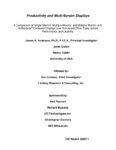TO
| Title | Date | Subject | Description | ||
|---|---|---|---|---|---|
| 1 |
 | 2012 Faculty Report | 2012 | 2012 Faculty Report; 2012 General Catalog; University of Utah catalogue; (Catalog) | The faculty report is generated by USpace through Academic Computing Services. It is provided as a companion to the Web archived version of the University of Utah catalogue;, found at http://content.lib.utah.edu/cdm/ref/collection/ir-eua/id/3085 |
| 2 |
 | 2013 Faculty Report; 2013 General Catalog | 2013 | University of Utah catalogue; (Catalog) | The faculty report is generated by USpace through Academic Computing Services. It is provided as a companion to the Web archived version of the University of Utah catalogue;, found at http://content.lib.utah.edu/cdm/ref/collection/ir-eua/id/3113 |
| 3 |
 | Study of gas evolution during oil shale pyrolysis by TQMS | 1988-02 | gas evolution; oil shale pyrolysis; TQMS; oil shale; evolution profiles | Real-time gas evolution during pyrolysis of two Green River Formation (Colorado) oil shales, one eastern U.S. Devonian shale, and two Chinese shales was monitored using a triple quadrupole mass spectrometer (TQMS). We calculated kinetic parameters for hydrocarbon generation. For water, carbon oxides... |
| 4 |
 | A report to Idaho National Engineering Laboratory | 1987 | Three Texas lignites (Jewett, Big Brown, and Bastrap), weathered and fresh tar sand, weathered and fresh Gilsonite and weathered oil shale have been studied using Py-MS (pyrolysis mass spectrometry) and further analyzed using the SIGMA program. | |
| 5 |
 | Comparison of methods for measuring kerogen pyrolysis rates and fitting kinetic parameters | 1987-03-23 | We determine rates of product evolution during pyrolysis of several petroleum source rocks and isolated kerogens by nonisothermal techniques, including Rock Eval pyrolysis and pyrolysis-MS/MS. The resulting data are analyzed by nonlinear regression and simpler correlation techniques in terms of disc... | |
| 6 |
 | Shale oil value enhancement research - Quarterly report: October 1 - December 31, 1993 | 1993 | Shale oil; value enhancement; molecular types of shale oil | The first year of this effort was focussed on the following broad objectives: -Analyze the molecular types present in shale oil (as a function of molecular weight distribution ); - Determine the behavior of these molecular types in liquid-liquid extraction; -Develop the analytical tools needed to sy... |
| 7 |
 | Application of a self-adaptive detector system on a triple quadrupole ms/ms to high explosives and sulfur-containing pyrolysis gases from oil shale | 1983-12 | A totally computerized triple quadrupole MS/MS is being extended into a dynamic, self-adaptive chemical analysis system at Lawrence Livermore National Laboratory. These first efforts toward Artificial Intelligence guided instrumentation (i.e. Expert Systems) involve the implementation of a self-adap... | |
| 8 |
 | Metallopetroporphyrins as process indicators: mass spectral identification of Ni (ETIO) and Ni (DPEP) homologous series in Green River shale oil | 1994-12-05 | mass spectral identification; Green River shale oil; shale oil | Mass spectrometry (MS) of the porphyrin fraction of a demetallated shale oil from the LLNL Hot-Recycled-Solids retorting process exhibited homologous series of C25 to C33 (C28 maximum) for etio and C26 to C36 (C30 maximum) for DPEP (isocyclic) porphyrins, respectively. The sum of intensities after b... |
| 9 |
 | An evaluation of triple quadrupole ms/ms for on-line analyses of trace sulfur compounds from oil shale processing | 1985 | In order to effectively reduce sulfur gas content from shale processing to environmentally acceptable levels, H2S, COS, S02 and CH3SH plus trace sulfur compounds must be removed. Of these, the trace sulfur compounds have not been well characterized but should be known to ppm levels In order to optim... | |
| 10 |
 | Productivity and multi-screen displays | 2003-07-18 | Computer displays; Office productivity | A Comparison of Single Monitor, Multiple Monitor, and Multiple Monitor with Hydravision®Computer Displays over Simulated Office Tasks across Performance and Usability |
| 11 |
 | Further comparison of methods for measuring kerogen pyrolysis rates and fitting kinetic parameters | 1988-01-20 | measuring methods; kerogen pyrolysis rates; fitting kinetic parameters; kerogen pyrolysis; pyrolysis kinetics; Rock-Eval; pyrolysisMS/MS; hydrous pyrolysis; petroleum generation | We compare rates of product generation during pyrolysis of several petroleum source rocks and isolated kerogens by nonisothermal techniques, including Rock-Eval pyrolysis, condensed oil evolution, and pyrolysis MS/MS. We discuss problems related to temperature calibration in the Rock-Eval instrument... |
| 12 |
 | Economic potential of the P.R. Spring oil-impregnated deposit, Uinta Basin, Utah | 1984-08 | The P.R. Spring oil-impregnated sandstone (tar sand) deposit is located in the southeastern portion of the Uinta Basin, approximately 50 miles northwest of Grand Junction, Colorado. These oil impregnated sandstones are in the Eocene Green River Formation and five zones have been identified. These zo... | |
| 13 |
 | Pyrolysis of Sunnyside (Utah) Tar Sand: Characterization of volatile compound evolution | 1988 | tar sand; pyrolysis | Sunnyside (Utah) tar sand was subjected to programmed temperature pyrolysis and the volatile products were detected by tandem on-line mass spectrometry (MS/MS) in real time analyses. A heating rate of 4°C/min from room temperature to 900°C was employed. Evolution of hydrogen, light hydrocarbons, n... |
| 14 |
 | Shale oil value enhancement research - Qarterly report: July 1 - September 30, 1994 | 1994 | shale oil; value enhancement; process sequence alternatives | Activities during this quarter focused on using the phase-l results to define process sequence alternatives for phase-ll. Two process alternatives have been devised while obtaining the desired marketable product slate. The status of required process units has been evaluated. While there are some uni... |
| 15 |
 | Rates and mechanisms of oil shale pyrolysis: A chemical structure approach | 2014-11 | Green River oil shale; oil and natural gas technology; oil shale pyrolysis; chemical structure of oil shale | Three pristine Utah Green River oil shale samples were obtained and used for analysis by the combined research groups at the University of Utah and Brigham Young University. Oil shale samples were first demineralized and the separated kerogen and extracted bitumen samples were then studied by a host... |
| 16 |
 | Identification by 13C NMR of carbon types in shale oil and their relationship to pyrolysis conditions | 1983-04 | shale oil; multiple-pulse techniques; shale oil characterization; identification of carbon types; pyrolysis conditions | A number of samples of shale oil prepared under various conditions have been examined by 13C NMR using multiple-pulse techniques that allow carbon-type assignments. Previous assignments by Netzel et al (1981) are confirmed and several new ones made. Product chemistry is then examined as a function o... |
| 17 |
 | Shale oil value enhancement research - Quarterly report: June 1 - August 31, 1993 | 1993 | shale oil; value enhancement; shale oil-derived products | All tasks are on schedule, or ahead of schedule. Particular progress has been made in identifying industrial entities, commodities and specialty products of target interest for shale oil-derived products. There is clearly a major emphasis worldwide on new chemicals and shale oil-derived structures a... |
| 18 |
 | Evaluation Committee, October 9-11, 2006 | 2006-09-26 | Accreditation; Higher Education, University of Utah | Northwest Commission of Colleges and Universities Evaluation Committee |
| 19 |
 | Geologic summary report of the 1986 exploration program, Sunnyside tar sands project, Carbon County, Utah--volume 1 | 1987-07-19 | geologic summary report; exploration program; Sunnyside tar sands project; hydrocarbon leases; tar sand. | The 1986 exploration program focused on detailed geological and geophysical field work in outlying areas of hydrocarbon leases east of Mt. Bartles. Field work was also completed in the Whitmore Canyon area. The field program extended from June 16 through September 19. During this time geological and... |
| 20 |
 | Phase 2: Clean and secure energy from coal: Quarterly progress report: April 1, 2010 to June 30, 2010 | 2010-08-01 | domestic coal resources; CO2 capture; stationary power generation; DQMOM approach | The University of Utah is pursuing research to utilize the vast energy stored in our domestic coal resources and to do so in a manner that will capture CO2 from combustion from stationary power generation. The research is organized around the theme of validation and uncertainty quantification throug... |
| 21 |
 | Lawrence Livermore National Laboratory oil shale project (Nov 1984) | 1984-11 | retort modeling; oil shale; sulfur containing gases; TQMS; recycle gas | I. Retort Modeling. II. Sulfur Containing Gases by Triple Quadruple Mass Spectrometer (TQMS), both Grab and On-Line Analysis. III. Visitors. |
| 22 |
 | UUSAC parking request 1993-1994 | 1994 | Committees | Notes, letters and memos of the University of Utah Parking, Transportation, Traffic Modeling Project Settering Committee. |
| 23 |
 | A comparison of biomakers in gilsonite, oil shale, tar sand and petroleum from Threemile Canyon and adjacent areas in the Uinta Basin, Utah | 1992 | Gilsonite; Oil shale; Tar sand; Petroleum; Threemile Canyon; Uinta Basin; Utah; Green River; Hopane; Sterane; Carotenoid biomarkers; Alginite; GC/MS; Ion fragmentograms; Biodegradation; Maturation; Oil shale outcrops; Bluebell-Altamont; Red Wash field; Bitumen; Pyrolysis; Py-GC/MS; Curie-point pyrol... | Relationships between gilsonite, oil shale and petroleum were investigated by comparison of hopane, sterane and carotenoid biomarkers. Samples examined were alginite, gilsonite, oil shale, tar sand and petroleum. Comparison of peak distributions in specific GC/MS ion fragmentograms of the above hydr... |
| 24 |
 | Clean and secure energy from coal, oil shale, and oil sands: Revised quarterly progress report: April 1, 2009 to June 30, 2009 | 2009-08-13 | CASE; Energy development; Electric power generation; Liquid transportation fuels; Coal; Oil sands; Oil shale; Clean Coal Program; Oil Shale and Sands Program; OSSP; Policy Environment, and Economics Program; PEEP; CO2 capture; sequestration; Gasification; Chemical looping combustion; CLC; Ash-partit... | The University of Utah Clean and Secure Energy (CASE) project is pursuing interdisciplinary, cradle-to-grave research and development of energy for electric power generation and for liquid transportation fuels from the abundant domestic resources of coal, oil sands, and oil shale. Its work is divide... |
| 25 |
 | Gasification studies - Task 4 topical report, Utah Clean Coal Program, Reporting period October 2009 - July 2011 | 2011-10 | Gasification; pressurized entrained-flow coal gasifiers; coal | A key objective of the Task 4 activities has been to develop simulation tools to support development, troubleshooting and optimization of pressurized entrained-flow coal gasifiers. The overall gasifier models (Subtask 4.1) combine submodels for fluid flow (Subtask 4.2) and heat transfer (Subtask 4.3... |
